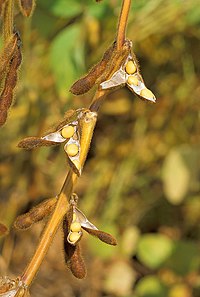
Photo from wikipedia
Abstract Soy protein is a commonly used functional ingredient. Despite its versatility, modifications of soy proteins could further enhance its functionalities. The objective of this study is to investigate the… Click to show full abstract
Abstract Soy protein is a commonly used functional ingredient. Despite its versatility, modifications of soy proteins could further enhance its functionalities. The objective of this study is to investigate the effect of l -histidine on physicochemical and functional properties of soy protein isolate (SPI) in the presence of 0, 0.1, and 0.6 M NaCl. The incorporation of l -histidine improved SPI solubility and decreased turbidity regardless of the salt concentrations. Notably, at 0.1 M NaCl, the incorporation of 0.3% l -histidine more than doubled the SPI solubility. Reactive sulfhydryl groups and surface hydrophobicity of the SPI decreased up to 24.2% and 38.6%, respectively, by the l -histidine treatment. The SPI-histidine interactions facilitated exposure of tryptophan residues in the absence of salt while mitigated salt-induced protein unfolding. With no salt, 0.3% l -histidine improved the emulsifying activity and stability of the SPI by 11.5% and 9.2%, respectively. At 0.1 M NaCl, 0.3% l -histidine did not improve the emulsifying activity but increased the emulsion stability by 30.1%. At 0.6 M NaCl, 0.3% l -histidine induced a 25.4% increase in emulsifying activity while no change in emulsion stability. In conclusion, l -histidine can be used as a functional ingredient to enhance the performance of SPI in various food formulations.
Journal Title: Lwt - Food Science and Technology
Year Published: 2021
Link to full text (if available)
Share on Social Media: Sign Up to like & get
recommendations!